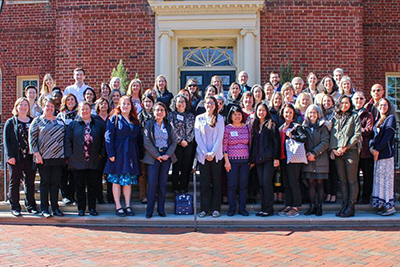February 25, 2020
UW HPRC Researchers Take Part in Unique Journal Supplement
Creating Awareness of Cancer Prevention Disparities Through National Network Collaboration

Researchers with the University of Washington Health Promotion Research Center (UW HPRC) played a key part in producing a supplemental issue of the “Preventive Medicine” journal, using collaboration to elevate their scientific findings and identify disparities in public health as part of the CDC’s Cancer Prevention and Control Research Network (CPCRN).
The supplement’s 12 papers, published in December 2019, illustrate the types of research that are possible within a network of geographically dispersed centers that are linked by a common cause — reducing cancer burden in diverse populations.
Two UW HPRC researchers were first authors on papers in the journal — Wendy Barrington and Linda Ko (pictured above). Barrington is an affiliate UW HPRC investigator who earned her PhD in Epidemiology from UW; Ko is an affiliate UW HPRC investigator and director of Fred Hutch’s Health Communication Research Center. Ko was also a co-author in the supplement. Four other UW HPRC researchers were co-authors in the journal — Barbara Baquero, Allison Cole, Christine Kava, and Thuy Vu. UW HPRC Director Peggy Hannon was a guest editor for the supplement and co-author on two papers.
Within CPCRN, the UW Health Promotion Research Center (UW HPRC) specializes in measuring the network’s impact in tangible and meaningful ways for a broad audience of partners. The papers written by UW HPRC researchers in the supplement describe the network’s impact on research, implementation science, practice for professionals, and ultimately the communities they serve.
Ko’s paper used an adapted framework that focused on five areas — disseminating science, creating awareness, catalyzing action, effecting change, and shaping the future — to capture CPCRN’s scientific impact beyond peer-reviewed publications.

“Though these five domains are interrelated and not necessarily successive, disseminating science can create awareness of research knowledge and expertise,” Ko said. “Increased awareness, in turn, can lead to collaboration that catalyzes action through advocacy, training, practice improvement, and new research. These efforts then effect change in capacities, practices, and policies with the potential to shape future health outcomes.”
These real-world impacts and activities include changes to technology that support tobacco quitline referrals and the creation of Kentucky state legislation supporting HPV vaccinations for adolescents as informed by a CPCRN workgroup.
“To increase scientific impact, CPCRN may also want to focus on advocacy to instigate change in the scientific and policy communities to ensure that activities beyond peer-reviewed publications are equally valued and academic training and funding are aligned with these activities,” Ko wrote in her paper.

While Ko’s paper outlines what can be measured to show a more complete view of success, additional papers in the supplement also take on real-world application of resources and practices. Barrington’s work is a key example, specifically focusing on patient navigators who help people access and complete cancer screening.
While patient navigation is an evidence-based strategy for improving cancer screening rates, there has been limited data on how this is actually accomplished. Barrington conducted the first survey among patient navigators affiliated with two national CDC administered cancer screening programs that serve people who have low incomes and are uninsured or underinsured. While navigators reported that patients had high levels of structural barriers to screening (e.g., transportation challenges and conflicts with work hours), most navigation activities focused on addressing patient-level barriers (e.g., understanding the cancer screening process and appointment reminders). Detailed descriptions of patient barriers and navigation activities can help program administrators and partner organizations adjust practices and messaging to be more patient-centered, as well as more supportive of navigators in their work to promote equity in cancer control.
“In this supplemental issue, CPCRN researchers take on two tasks that are essential to reducing disparities in cancer outcomes,” said Jennifer Leeman, a guest editor on the issue and principal investigator of the University of North Carolina, the CPCRN coordinating center. “First, they examine the multi-level factors that are contributing to cancer disparities, and, second, they identify strategies to speed the implementation of cancer screening interventions across the different levels where factors occur. Taken together, these articles report findings that will aid public health practitioners, policymakers, and others as they design and implement interventions to reduce the burden of cancer in underserved communities.”
Presently, CPCRN includes over a hundred investigators from departments of epidemiology, health behavior, medicine, nursing, nutrition, psychology, and sociology, among others. Networking across centers also allows CPCRN to leverage each collaborating center’s network of state and local partners, such as the UW HPRC Alliance for Reducing Cancer, Northwest (ARC NW). As a result, cross-center research studies engage research partners and study participants from diverse settings and populations across the United States.
UW HPRC is one of eight collaborating centers of CPCRN and contributes to the network through ARC NW. ARC NW is based at UW HPRC, although its members and affiliates are from multiple regional organizations, including Washington State Department of Health, Fred Hutchinson Cancer Research Center, Public Health-Seattle & King County, and Kaiser Permanente. Ko and Hannon serve as co-principal investigators of ARC NW.
The Published Articles
The supplement has been published open access by Elsevier, and the full issue is available for download. Articles included in the supplement can also be individually downloaded by following the links below:
- The cancer prevention and control research network: Accelerating the implementation of evidence-based cancer prevention and control interventions. (Guest Editor Commentary)
Leeman J, Glanz K, Hannon P, Shannon J. - The Cancer Prevention and Control Research Network (CPCRN): Advancing public health and implementation science (Funder Commentary)
White A, Sabatino SA, Vinson C, Chambers D, White MC. - Multilevel analysis in rural cancer control: A conceptual framework and methodological implications.
Zahnd WE, McLafferty SL, Eberth JM. - Financial Hardship among Rural Cancer Survivors: An Analysis of the Medical Expenditure Panel Survey
Odahowski CL, Zahnd WE, Zgodic A, Edward JS, Hill LN, Davis MM, Perry CK, Shannon J, Wheeler SB, Vanderpool RC, Eberth JM. - Mortality-to-incidence ratios by US Congressional District: Implications for epidemiologic, dissemination and implementation research, and public health policy.
Eberth JM, Zahnd WE, Adams SA, Friedman DB, Wheeler SB, Hébert JR. - Challenges of using nationally representative, population-based surveys to assess rural cancer disparities.
Zahnd WE, Askelson N, Vanderpool RC, Stradtman L, Edward J, Farris PE, Petermann V, Eberth JM. - Estimating the impact of insurance expansion on colorectal cancer and related costs in North Carolina: A population-level simulation analysis.
Lich KH, O’Leary MC, Nambiar S, Townsley RM, Mayorga ME, Hicklin K, Frerichs L, Shafer PR, Davis MM, Wheeler SB. - Patient navigator reported patient barriers and delivered activities in two large federally-funded cancer screening programs.
Barrington WE, DeGroff A, Melillo S, Vu T, Cole A, Escoffery C, Askelson N, Seegmiller L, Gonzalez SK, Hannon P. - Mailed FIT (fecal immunochemical test), navigation or patient reminders? Using microsimulation to inform selection of interventions to increase colorectal cancer screening in Medicaid enrollees.
Davis MM, Nambiar S, Mayorga ME, Sullivan E, Hicklin K, O’Leary MC, Dillon K, Hassmiller Lich K, Gu Y, Lind BK, Wheeler SB. - Understanding quality improvement collaboratives through an implementation science lens.
Rohweder C, Wangen M, Black M, Dolinger H, Wolf M, O’Reilly C, Brandt H, Leeman J. - Advancing the use of organization theory in implementation science.
Leeman J, Baquero B, Bender M, Choy-Brown M, Ko LK, Nilsen P, Wangen M, Birken SA. - Putting Evidence Academies into action: Prostate cancer, nutrition, and tobacco control science.
Glanz K, Green S, Avelis J, Melvin CL. - An application of the Science Impact Framework to the Cancer Prevention and Control Research Network from 2014-2018.
Ko LK, Jang SH, Friedman DB, Glanz K, Leeman J, Hannon PA, Shannon J, Cole A, Williams R, Vu T.
These publications are a product of the Prevention Research Centers Program at the Centers for Disease Control and Prevention. The findings and conclusions in these publications are those of the authors and do not necessarily represent the official position of the Centers for Disease Control and Prevention or the National Institute of Health. The Cancer Prevention and Control Research Network is funded through Cooperative Agreements [3 U48 DP005013-01S1A3, 3 U48 DP005000-01S2, 3 U48 DP005053-01S1, 3 U48 DP005017-01S8, 3 U48 DP005006-01S3, 3 U48 DP005030-01S5, 3 U48 DP005021-01S4, 3 U48 DP005014-01S2] from the Centers for Disease Control and Prevention and National Cancer Institute.